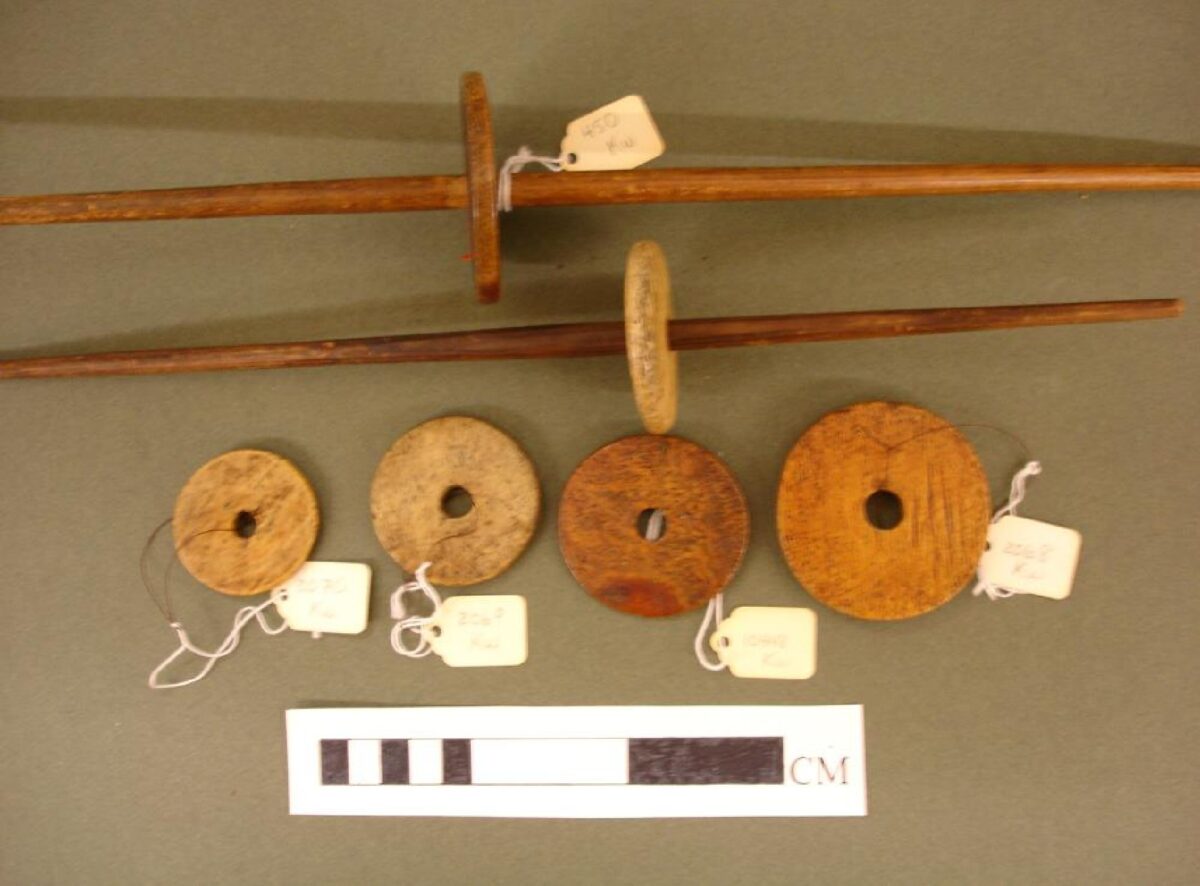December 6, 2016.
By Grant Keddie.
Introduction and Spindle Whorls in the Archaeology Collection of the Royal BC Museum
Introduction
In order to provide a broader understanding of the earlier history and origins of both historic and pre-contact spindle whorls used in British Columbia, I will provide a description with images of all the spindle whorls in the Archaeology and Ethnology collection of the Royal B.C. Museum.

This will be presented in three Parts: (1) Introduction and Spindle Whorls in the Archaeology Collection of the Royal BC Museum. (2) Small Spindle Whorls in the Ethnology Collection of the Royal BC Museum. (3) Large Spindle whorls from speakers of the Salish language family in the Ethnology Collection of the Royal BC Museum.
The archaeological record suggests that significant differences existed in the past. This project will look at the larger picture of all uses of spindle whorls in British Columbia, their age and distribution in earlier and more recent times.
Most of the discussion on this topic to date involves reference to the making of woven capes and blankets of mountain goat, dog hair and other materials using large spindle whorls. However, the majority of small spindle whorls in Museum ethnological collections that derive from the coast of British Columbia are related mainly to the production of fibers, such as stinging nettle, for the production of fishing nets. An overview for understanding this broader topic is presented here.
The Significance of Spindle Whorls in British Columbia
The weaving technology of First Nations of British Columbia is a popular topic. Designs on historic Salish Spindle whorls have had the greatest influence on what is termed modern Salish Art. Over recent decades Salish Artists have copied designs from Spindle whorls in Museum collections and have developed from these a wonderful array of new and creative designs that are a reflection of those early patterns.
The word Salish is, of course, a term used by linguists to refer to a number of different human populations that speak different languages that have a common origin. The common language origin indicates that these groups have interacted with each other to varying degrees at various times in the past, but each has their own history. The history of the use and expression of weaving technology will be different for some of these groups. We know, for example, in the historic period that some Salish speaking groups did not decorate their spindle whorls with designs.
The Interests of Archaeology
There is a desire to know the history and origins of the weaving of clothing, but the role of spindle whorls for other purposes is generally not understood. This project will put the broader role of spindle whorls in the public domain.
For Archaeologists, artifact typologies and where they fit into defined cultural phases play an important role in developing hypothesis about cultural development on the northwest coast.
What artifacts to include and exclude from trait lists defining cultural phases can be a very subjective exercise. Interpreting what the artifact represents in terms of cultural behavior can also be a subjective exercise.
Determining which spindle whorls were used for the production of different products and determining when this behavior began in the past would be crucial in making time specific statements about past human behavior.
Did the spinning of nettle for making nets precede the spinning of materials for clothing or were they both produced at the time of the introduction of spindle whorls?
Spindle whorls are a type of artifact that is not likely to have been independently developed, but rather introduced into the region. This seems to be the more typical pattern in other parts of the world. Knowing the function and timing of the introduction and/or local development of specific types of spindle whorls may help us better understanding the process by which it was introduced into this region and the source of its introduction.
Both internal and external cultural catalysts may underlie the explanation for the introduction of this new form of behavior. Does the introduction of the spindle whorl reflect a change in economy or a new technology for an existing economy? Is it a result of new trade and exchange with, or a borrowed idea from some outside culture?
In comparing the ethnographic record with the archaeological it is important to understand the nature of both. Archaeologists and ethnologists can make incorrect assumptions about the others data when they are not familiar with it. Knowing the specifics of when and where both the ethnographic and archaeological examples of spindles whorls were collected is important in making comparisons between them.
When comparing ethnographic spindle whorls with archaeological examples we need to ask if the ethnographic examples were actually used – or ones made for sale or made as models for collectors or museums. Are the whorls made in the early 20th century the same as those made in the early 19th century?
The biggest factor in the comparison of modern and ancient whorls will be in the nature of the raw materials. Wooden examples will be lost from the archaeological record except in the case of those found in extremely wet or dry conditions.
However, since almost all of the ethnographic examples of small whorls are made of sea mammal bone and stone, these should be found in archaeological sites.
Spindle Whorls in the Archaeology Collection of the Royal BC Museum
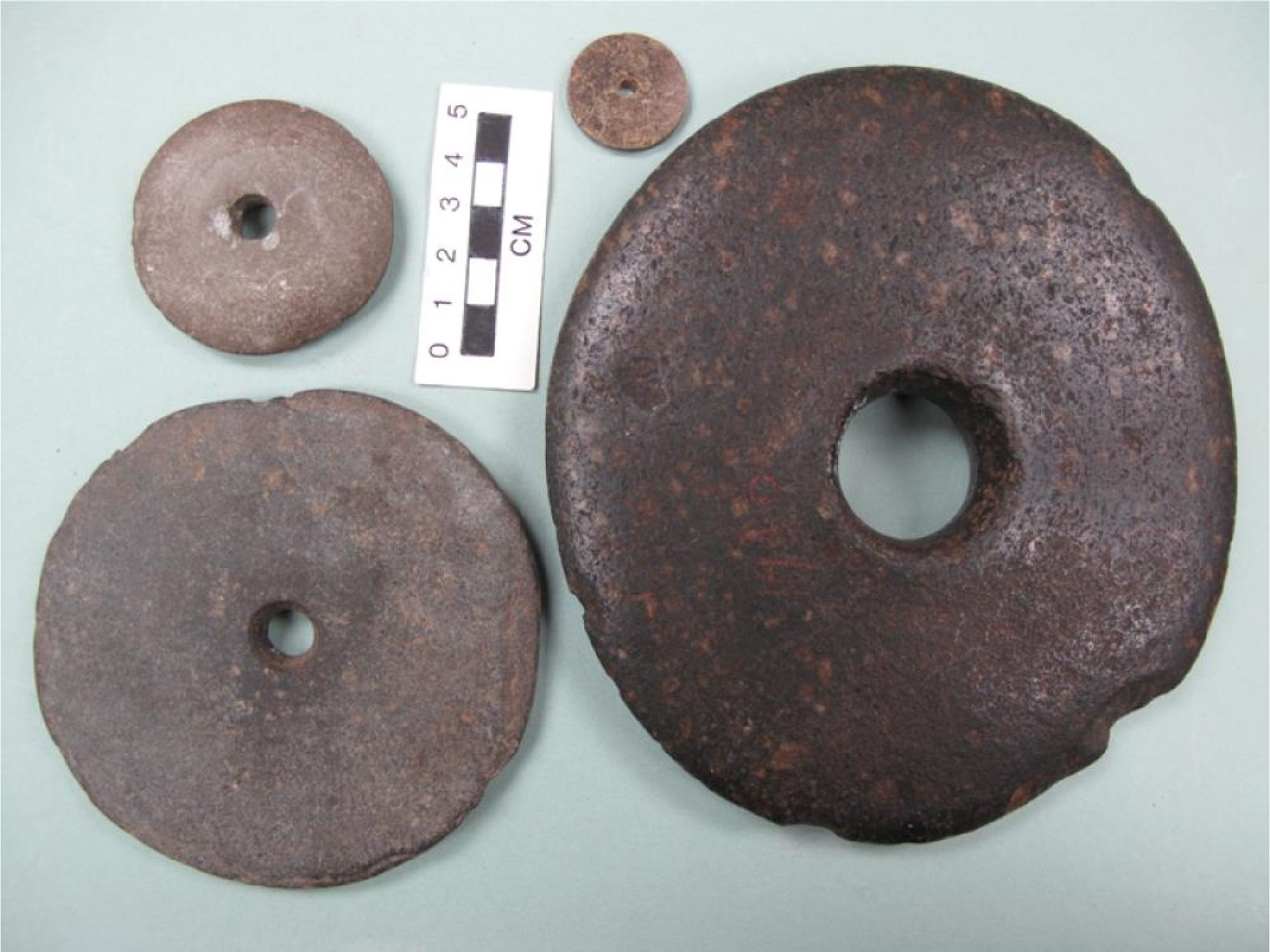
Identifying archaeological spindle whorls is not something that can always be done with certainty. Some archaeological examples are similar enough to known ethnographic examples. They are often finely made with a lenticular or flat cross-section. The hole for inserting the whorl on the spindle is usually well defined and in proportion to the size of the diameter of the whorl. The hole is usually well centered.
There are other bone and stone objects that seem to be more likely to be spindles whorls than anything else. These come in a variety of sizes. Spindle whorls in other parts of the world show considerable variation in size depending of what kind of material is being spun. A few of the 27 specimens described here deviate from the known historic examples, but are being
considered as possible whorls until further research can substantiate or reject them as whorls. There may be some elements of the spinning and weaving industry that are found in earlier times that do not have an historic equivalent. For example, the presence of spinning bowls (Keddie 2003)
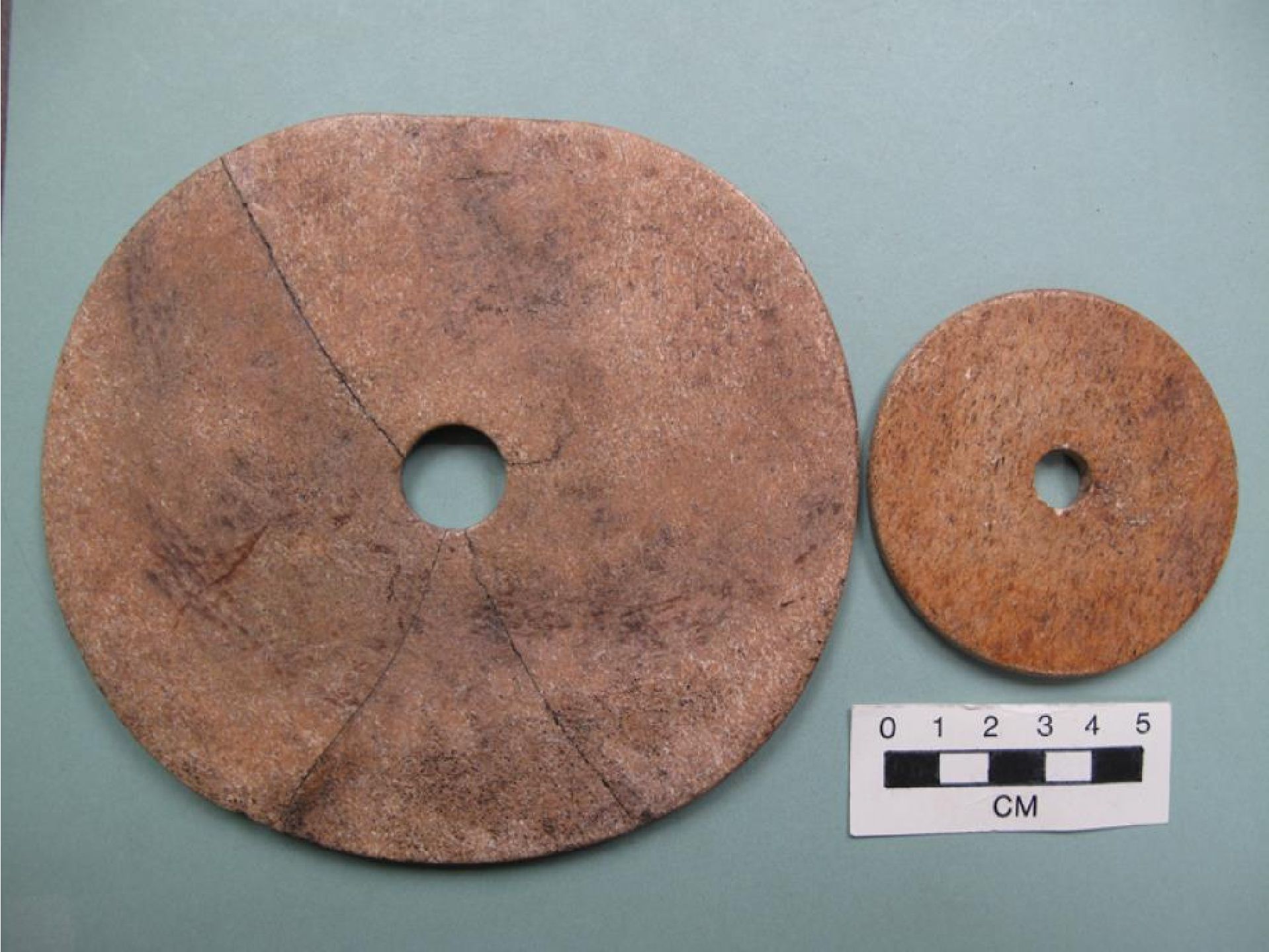
Description Notes
In some cases, sea mammal bone whorls have a smoother side that is the outer portion of the original bone and a rougher side with a more porous surface. Where this is clear, the smoother side will be considered the upper portion or top against which the fibre being spun accumulates.
The whorls will be described here in regional clusters of my own invention for comparative purposes. This is based on general geographic areas and in part reflects the current state of the collection.
South East End Vancouver Island. Pedder Bay to Nanaimo. (Total 11)
DcRt-Y:41 Cadboro Bay. Flat, rounded, but slightly rectangular, whale vertebrae epiphysis. The smoother top is nearly flat, while the bottom is convex only along a thicker middle portion. 155mm – 123 mm dia. Hole dia. 17mm. It varies in thickness from 12mm near the center to 5-6mm around the outer rim. Records show that this is from the Cadboro Bay archaeological site DcRt-15 [old accession 1932-1]. The porous bottom surface has an incised face on one half composed of two eyes and a mouth. On the top surface is a star-like pattern composed of two rings encircling the center hole with four triangular extensions that have long thin triangles in them, and two thinner arm-like extensions between the larger triangles extending to each side. Weight: 102 grams (portion missing – estimated original weight 120 grams). Surface collected by T.W.S. Parsons, 1932.
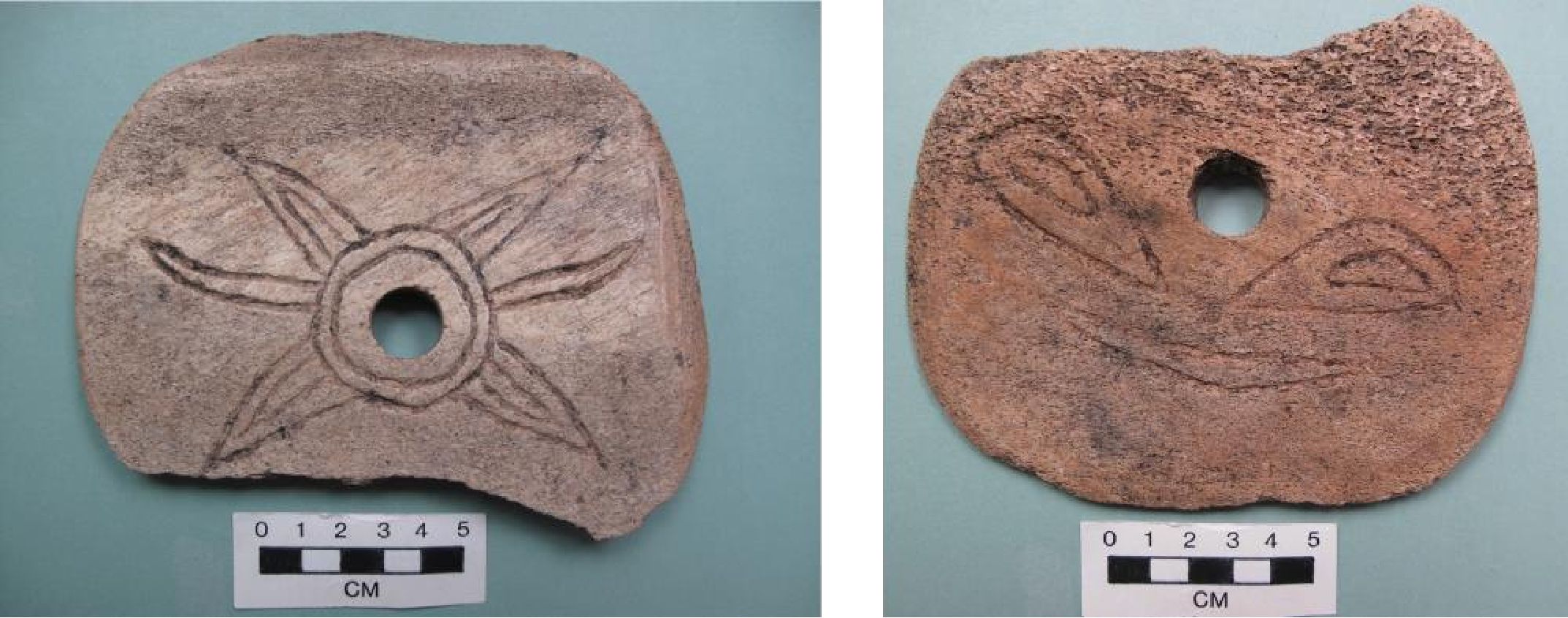
DcRt-15:1289. Cadboro Bay, Victoria. Bone whorl blank. Whale vertebrae epiphysis. This was shaped by chopping around the circumference with an adze. Flat with original smooth bone top surface and porous bottom surface. Maximum dia 15.5cm; Max. th. 1.5cm. Weight: 179 grams. (Old number 12650].
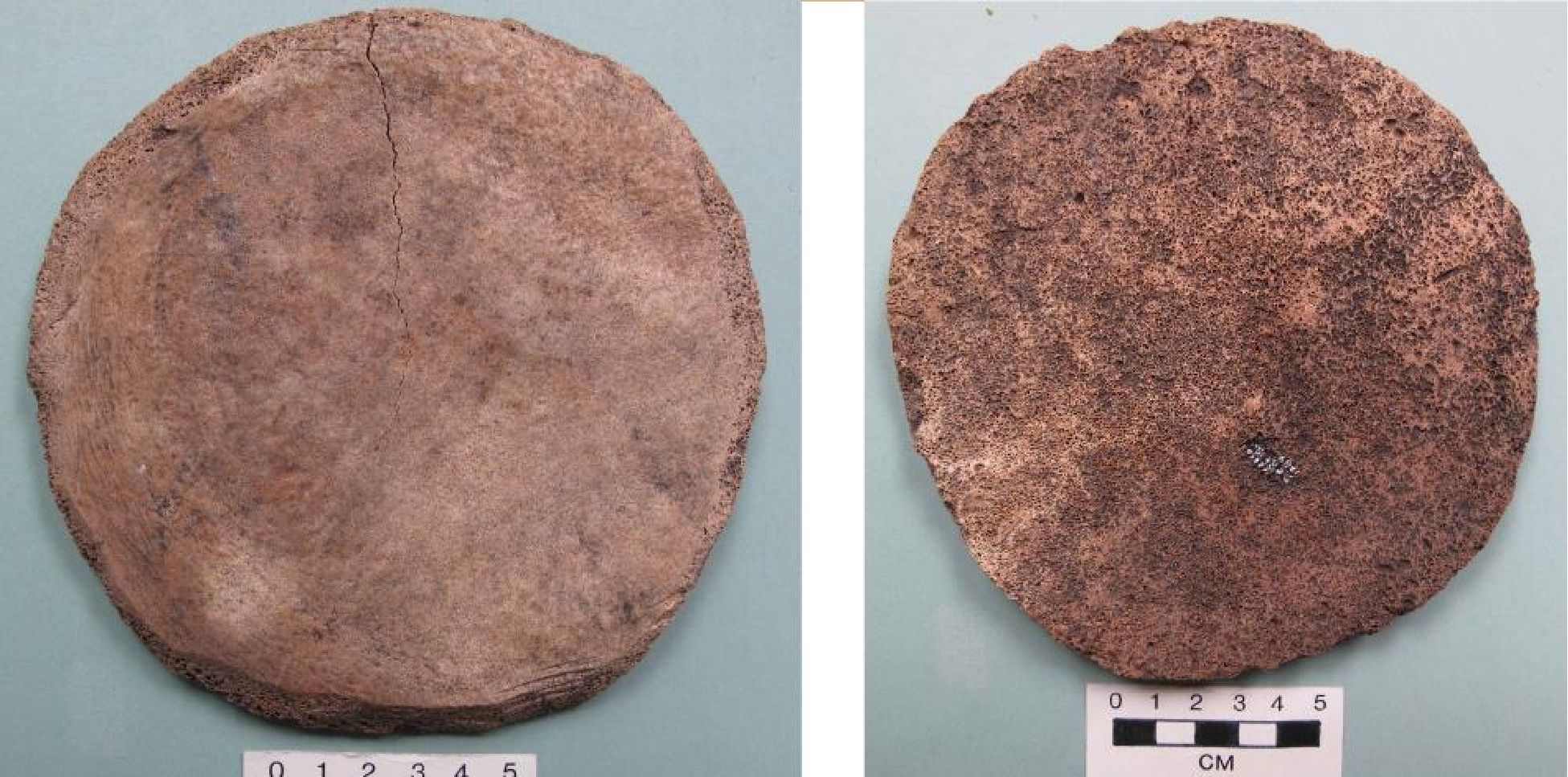
DcRu-25:1555. Victoria Harbour. Old Songhees Reserve. Portion (about 40%) of round to slightly rectangular whale vertebrae epiphysis. Flat smooth ground top surface and porous, ground, slightly convex bottom surface. Only slight remnant of center hole exists. The outer rim is flat sided with rounded edges. Maximum diameter present (144mm). Estimated original diameter based on continuance of outer rim is about 160mm. The radius from the hole remnant edge is 68mm. If the hole was the same size as the similar DcRt16:158 specimen, the diameter across this portion would be a minimum of 154mm. This whorl is larger from the hole to the edge than DcRt-16:158, and seems to have been slightly rectangular – suggesting that an original diameter of about 160mm is accurate. Thickness ranges from 9.5mm at hole to 6-7mm on the outer edge. Weight:(32.8 grams). Estimate of original weight is about 135 grams. Excavated form disturbed historic debris. This site was occupied from 1844-1911. It is likely that this whorl dates to the earlier period of the mid-19th century.
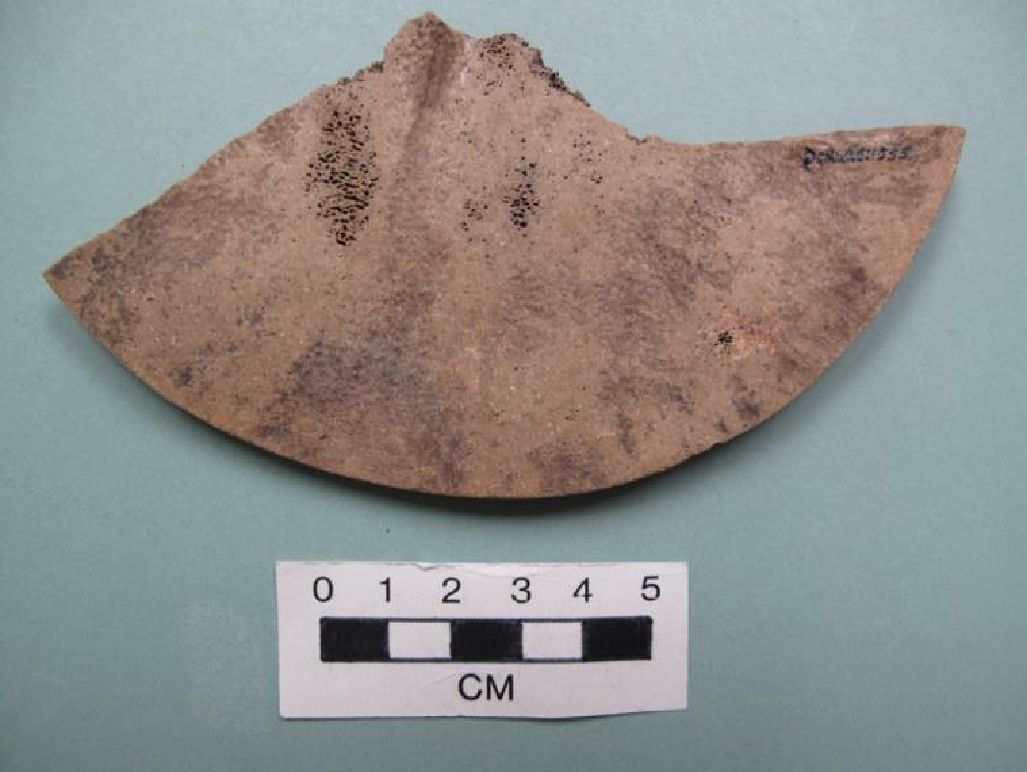
DcRt-16:158. McNeil Bay, Victoria. Whale vertebrae epiphysis. Nearly flat on the ground top – which is the original bone surface. The ground porous bottom is slightly convex. Diameter: 144mm by 132mm. Thickness varies from 4mm-5mm around the edges to 7mm near the centre. Hole diameter: 18mm. No raised area near the spindle hole. Outer bone cortex side more polished with wear patterns. Weight: 123.5 grams. This site has two bottom dates of around 500 years. The oldest (WAT1627, RH86-10; 560-+65) dates the base of the midden to the period around 1390 A.D. to 1455 A.D. A second date covers the period from A.D. 1445 – A.D. 1680.
Oral history refers to this site being occupied by the Chikawich people. It may have been last used in the early 1800s as a more permanent village, but used on a more temporary basis after this. The spindle whorl, therefore dates to a maximum of 500 years, but may be closer to a date of 200 years ago.
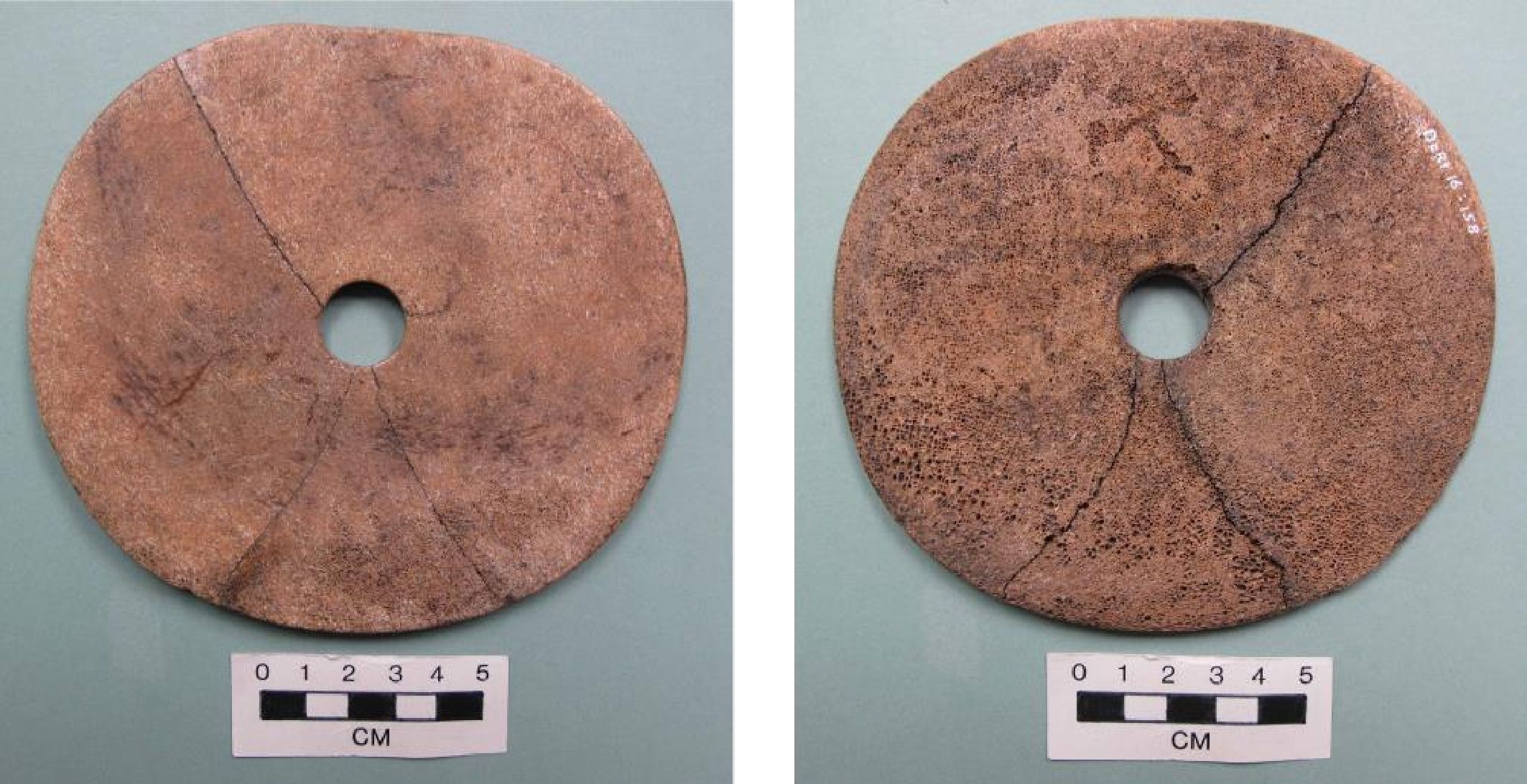
DcRt-16:335. McNeil Bay, Victoria. Whale vertebrae epiphysis bone. This small fragment is flat on the original ground bone top surface and convex on the bottom ground porous surface. There is no central whole present but the ground contours are the same as the outer edge of the whorl DcRu-12:1555. Diameter: (51mm). Width: (28mm). Thickness: 6mm on edge to (11mm) inward. Weight: (6.9 grams).
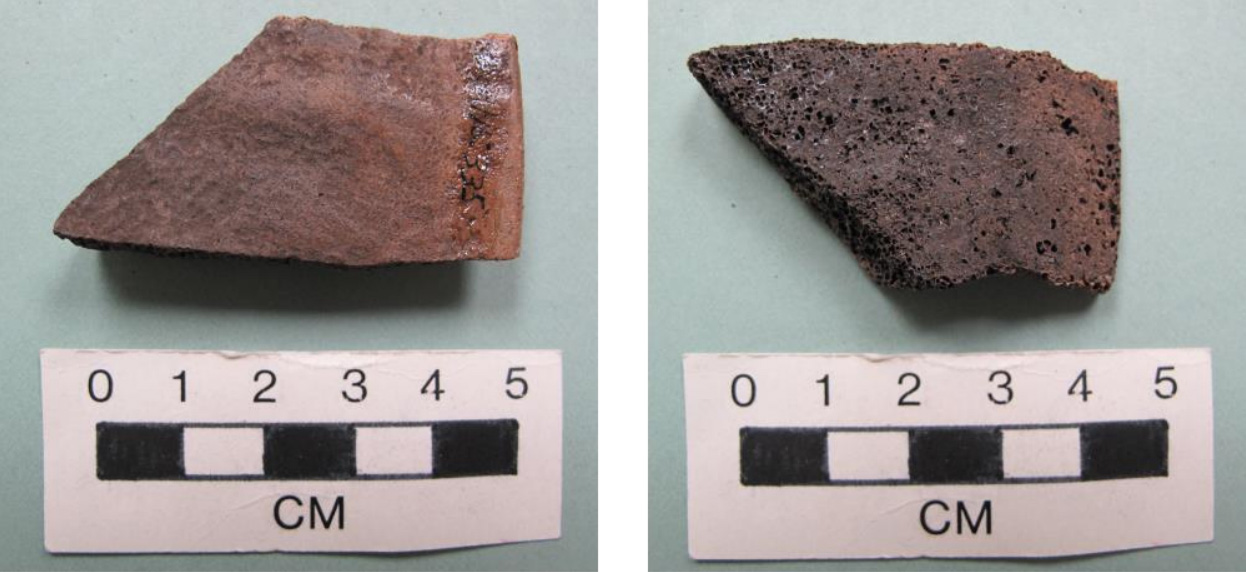
DcRv-1:733 Pedder Bay. Oval shaped, sea mammal bone vertebral epiphysis. Flat on both surfaces and flattened sides. Diameter: 73mm – 64mm; Thickness varies from 3mm to 5mm; Hole diameter is 7.5mm. Weight: 12 grams.

.DcRu-Y:63. Esquimalt Lagoon area. Small grey siltstone whorl fragment (about 22% present). One side is flat and the other slightly convex. It tappers from a thickness of 4.8mm at the hole to 3mm at the rim. Maximum diameter present (67mm). Original estimated diameter is about (78mm). Original hole diameter about 7mm. Old accession 75-57. Written on artifact:
“Seashore Belmont, A. N. Marrion”. Marrion was known to have collected other material from site DcRu2. This is likely the site that it came from. A series of radio-carbon dates places most of this site after 1000 B.P. Weight: 13.9 grams.
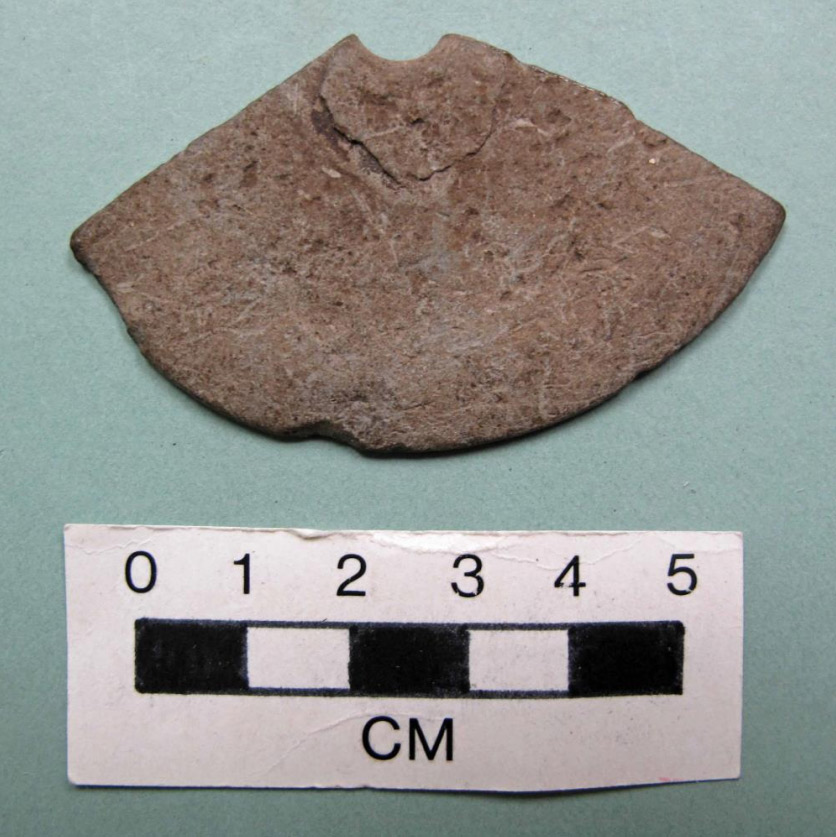
DcRu-Y:266. (DcRu-23). Finlayson Point, Victoria. Ground sea mammal bone. Nearly flat on both surfaces. Fragment only. Includes portion of central hole and portion that includes a section of original outer rim. Distance from hole edge to outer rim 55mm. Hole diameter 16mm. Thickness varies from 3.8mm on the outer rim to 5.5mm near the central hole. Original diameter estimated at 126mm. Collected by William A. Newcombe at a shell mound in Beacon Hill Park in 1902. The only site this description would fit at that time is the Finlayson Point site, DcRu-23. Weight: [23.4] grams. Original weight would be about (70 grams). This site dates within the last 1000 years and was likely last occupied in the mid-1700s.
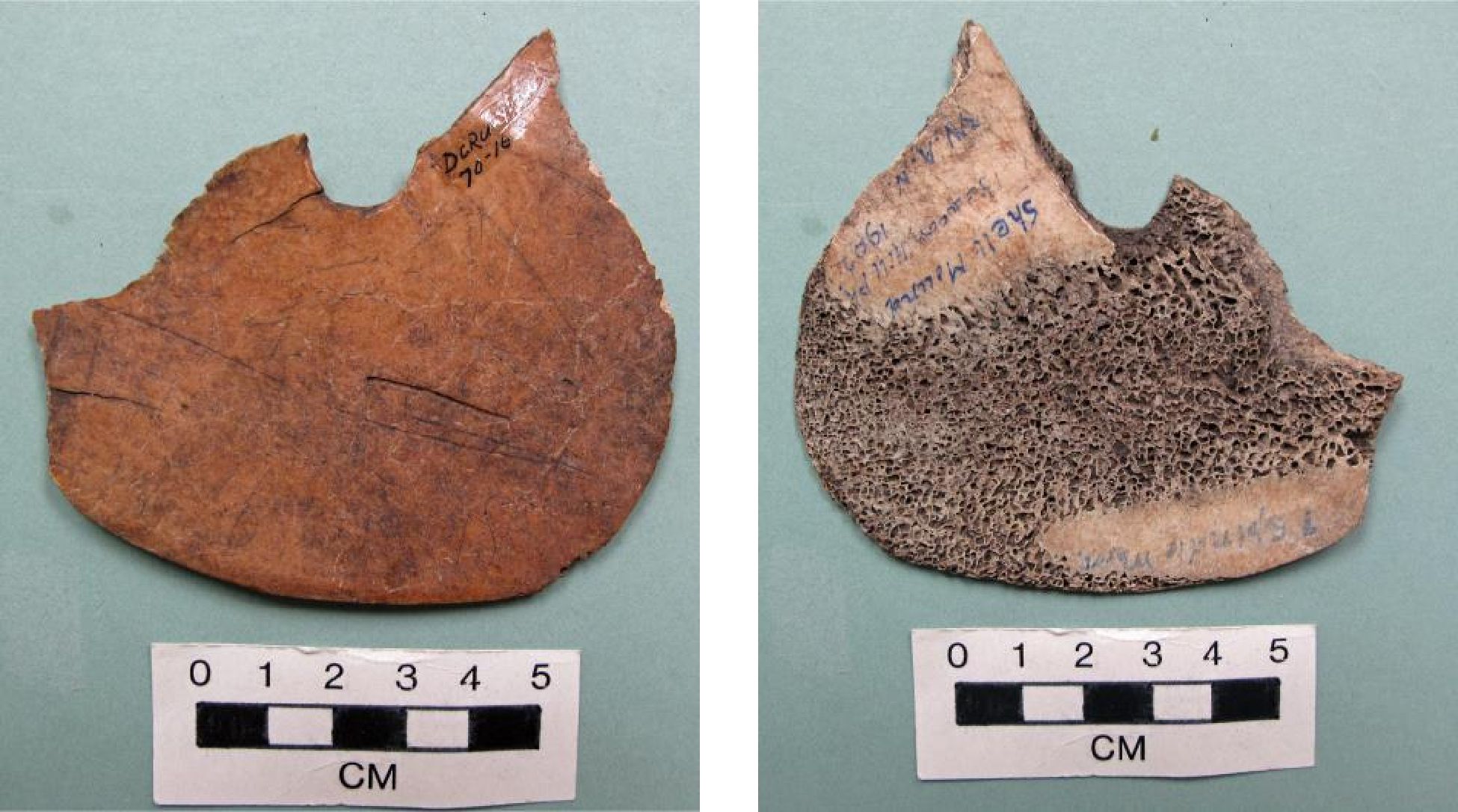
DeRu-1:2611. Sidney area. Whalebone whorl fragment (about 7/12 present). Flat on more porous bottom surface and slightly convex on top surface. Tapers from 9mm thick at hole to 4mm at rounded outer rim. Original hole dia. c.8mm. 50–52mm from hole edge to outer rim. Original diameter c. 114-118mm. Slightly rectangular. (Old accession 5489; From collection of A. and Francis J. Barrow – #358, from Barrow property). Weight: [52] grams. Original weight about 120 grams.

DeRv-Y:56. Cowichan region. Possible whorl? Oval shaped siltstone. Slightly bi- conical in cross-section. Bi-conically drilled central hole. Edges ground flat with
portions slightly rounded. Diameter ranges from 76mm – 89mm. Outer hole diameter 15mm; Inner hole 9mm. Thickness: 10mm – 13.5mm toward centre. Weight: 148.1 grams. Old accession # 275, donated by E.M. Skinner) On label “Cowichan. Mrs. Skinner, May 1890”. Smooth surface. This may also be a small net weight, but there are no other net weights like it in the region.
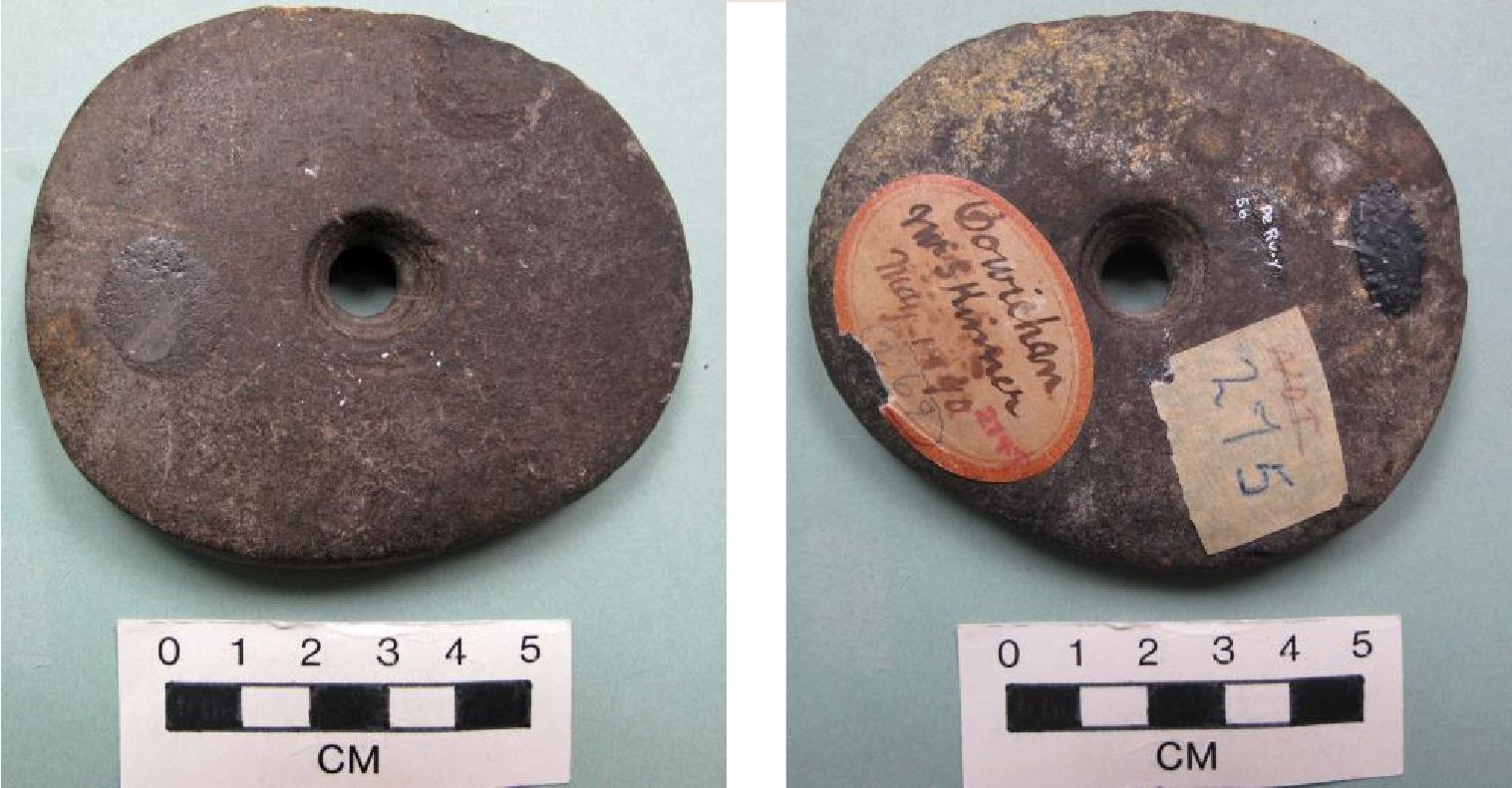
DgRx-Y:14. Nanaimo District. Large disc shaped stone with slight 2mm collar (raised rim around the hole edge). Bi-convex cross-section. Diameter: 144mm-164mm. Thickness varies from 25mm at the inner hole to 6mm on the outer edge. Hole diameter: 33mm. Raw material: Andesite. Weight: 623.3 grams. (Originally from the D. Steveson Collection, that became part of the Charles Newcombe Collection. Old accession #10946)
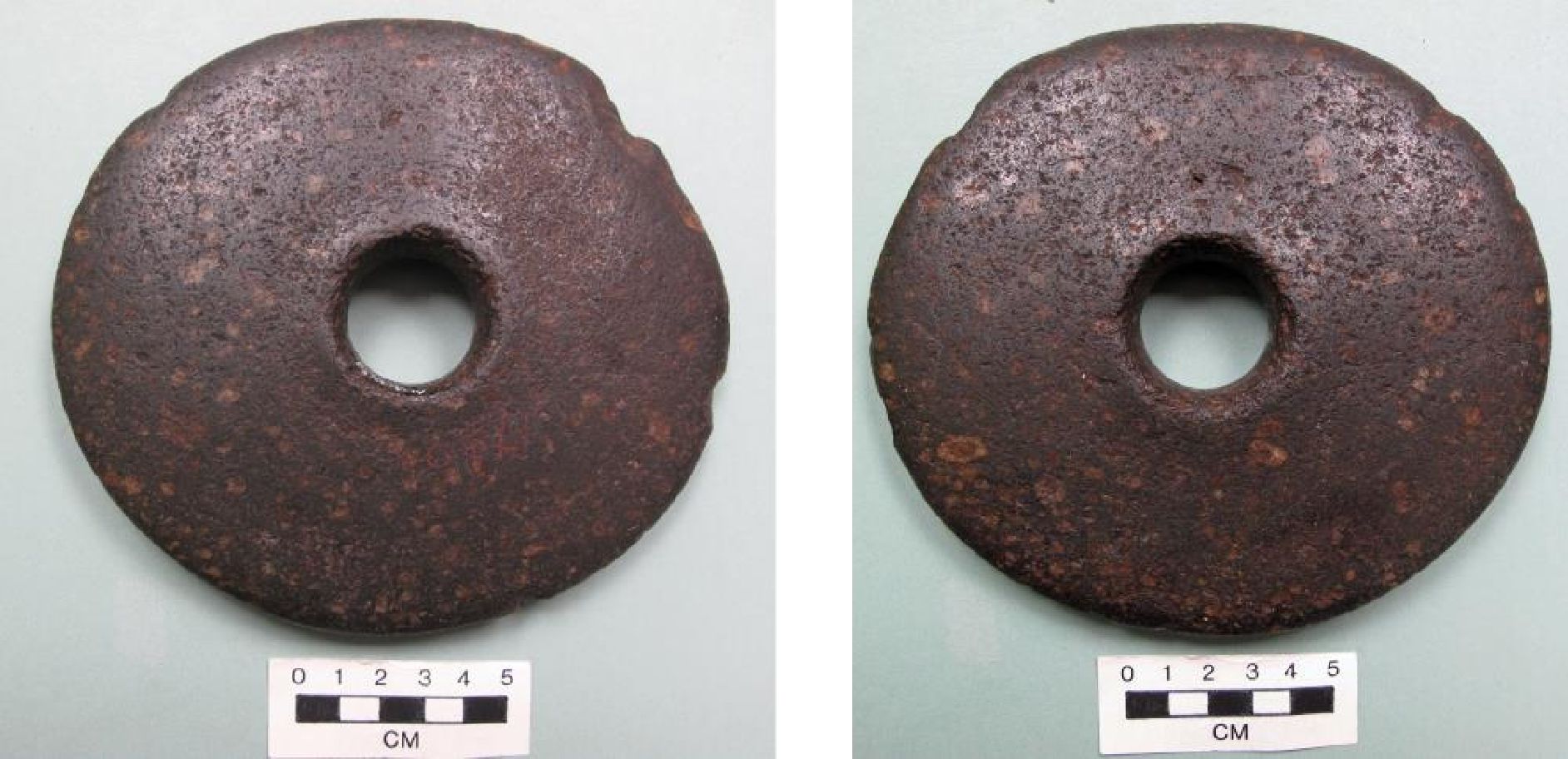
Gulf Islands (Total 4)
DfRu-24:749. Galiano Island. Active Pass. Georgeson Bay. Whorl fragment of whale vertebrae centrum epiphysis. Nearly flat top surface and slightly convex bottom surface. Weight :(30.8) grams. This has the characteristics of a whorl but is missing the portion where the central hole would be. Minimum diameter estimated at about 160mm-180mm.
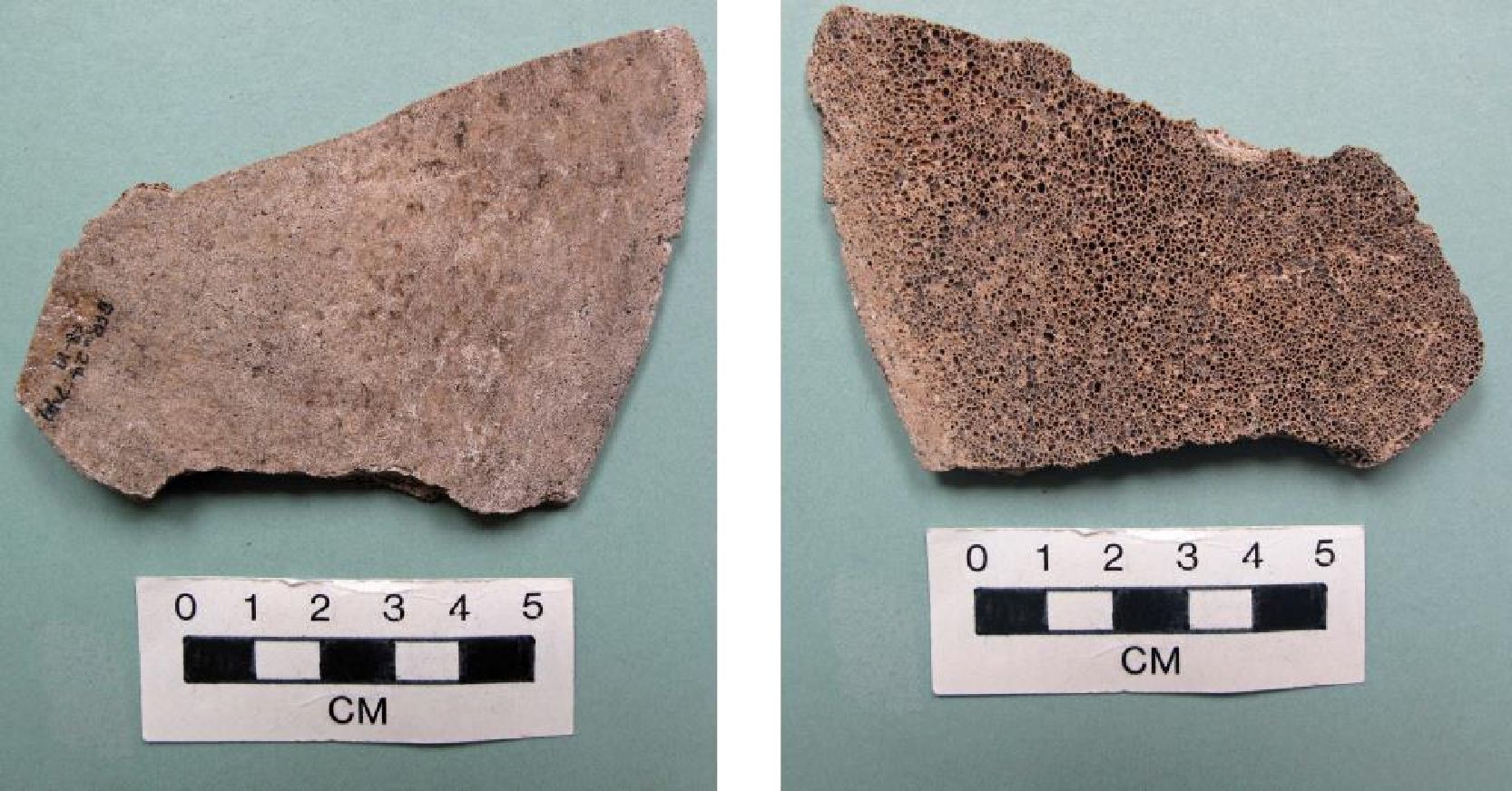
DfRu-24:1287. Galiano Island. Possible whorl? Very small round, flat stone with central hole. Edges ground flat. This is much smaller than any known ethnographic examples or any information provided in ethnological accounts in British Columbia, but does fit the size range of whorls in other parts of the world. It could be a decorative button or some other object? Diameter: 25.5mm; Thickness: 3mm; Hole size: 4mm. Weight: 2 grams. Accession 68-19.
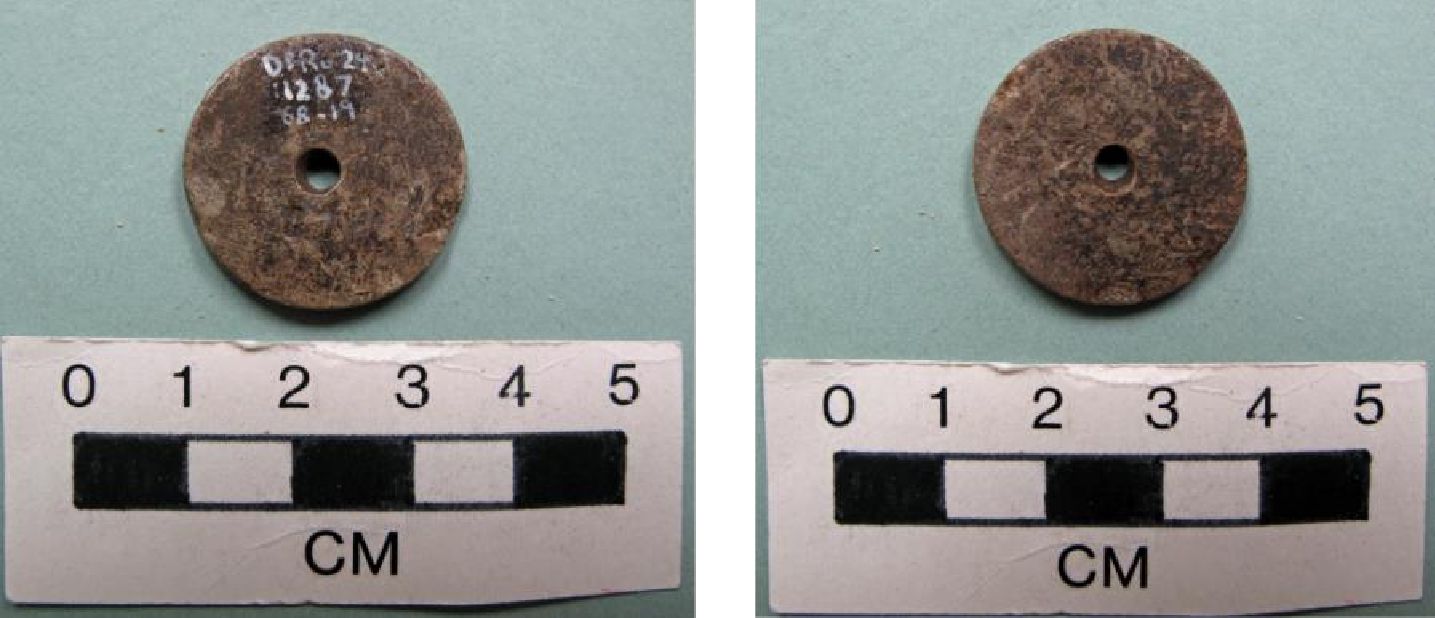
DgRw-4:2740. Gabriola Island. Flat slate whorl. Diameter: 56.8mm to 59mm. Thickness: Varies from 2.5mm to 3.0mm. Hole diameter: 6.5mm. Bi-conically drilled. Weight: 16 grams. Accession 1967.27. Excavation. David Burley 1988. False Narrows III component. Gulf of Georgia Cultural type (“with an approximate age between A.D. 1200 and the historic period”).
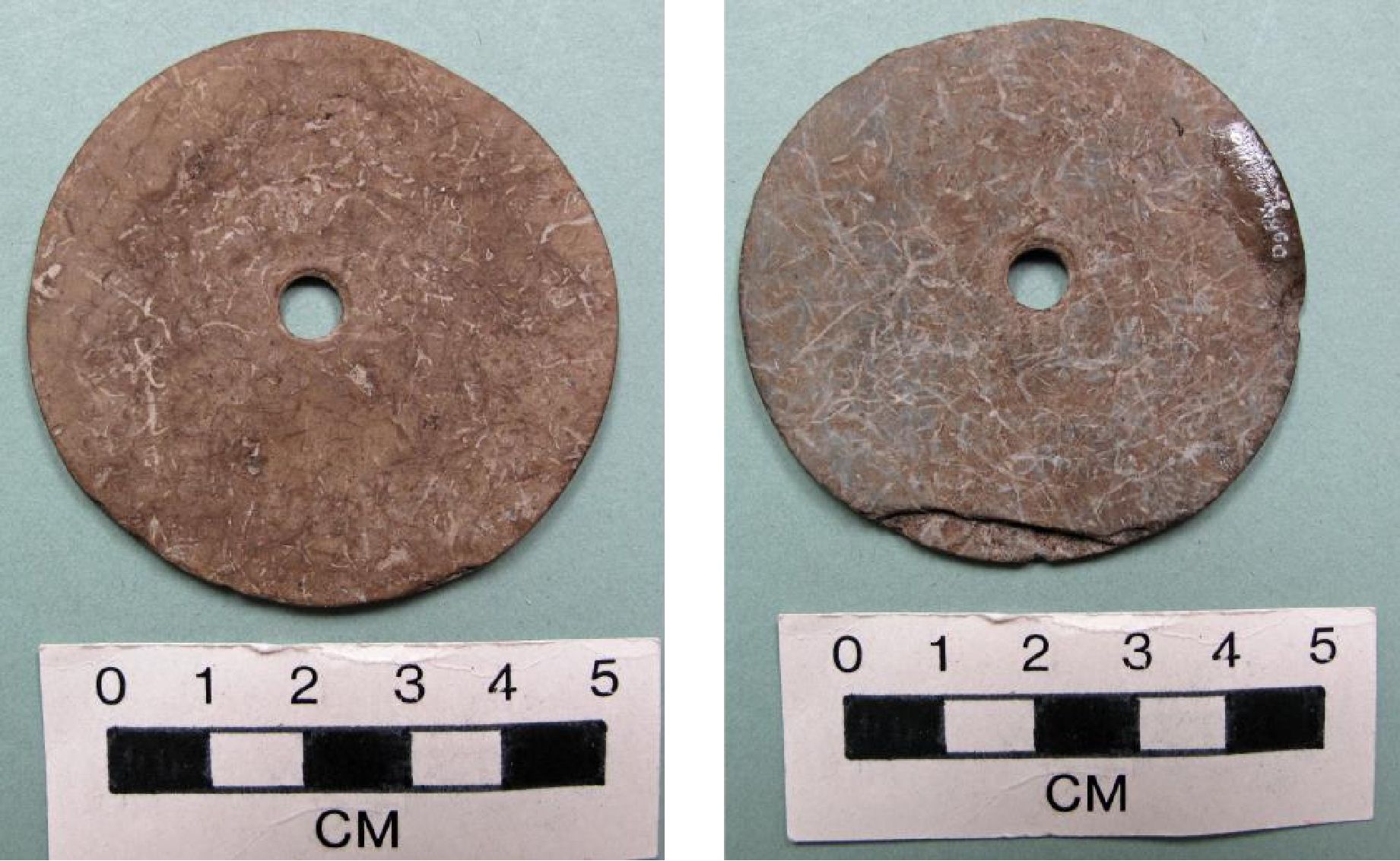
DeRt-1:103. Pender Island. Small flat sandstone whorl. Diameter 38-42mm. Even thickness of 7mm with well defined, steep edges. Hole diameter: Inner 6mm; outer cut area 10-12mm. (#94 of Herbert A. Spalding collection). Weight:16.1 grams.
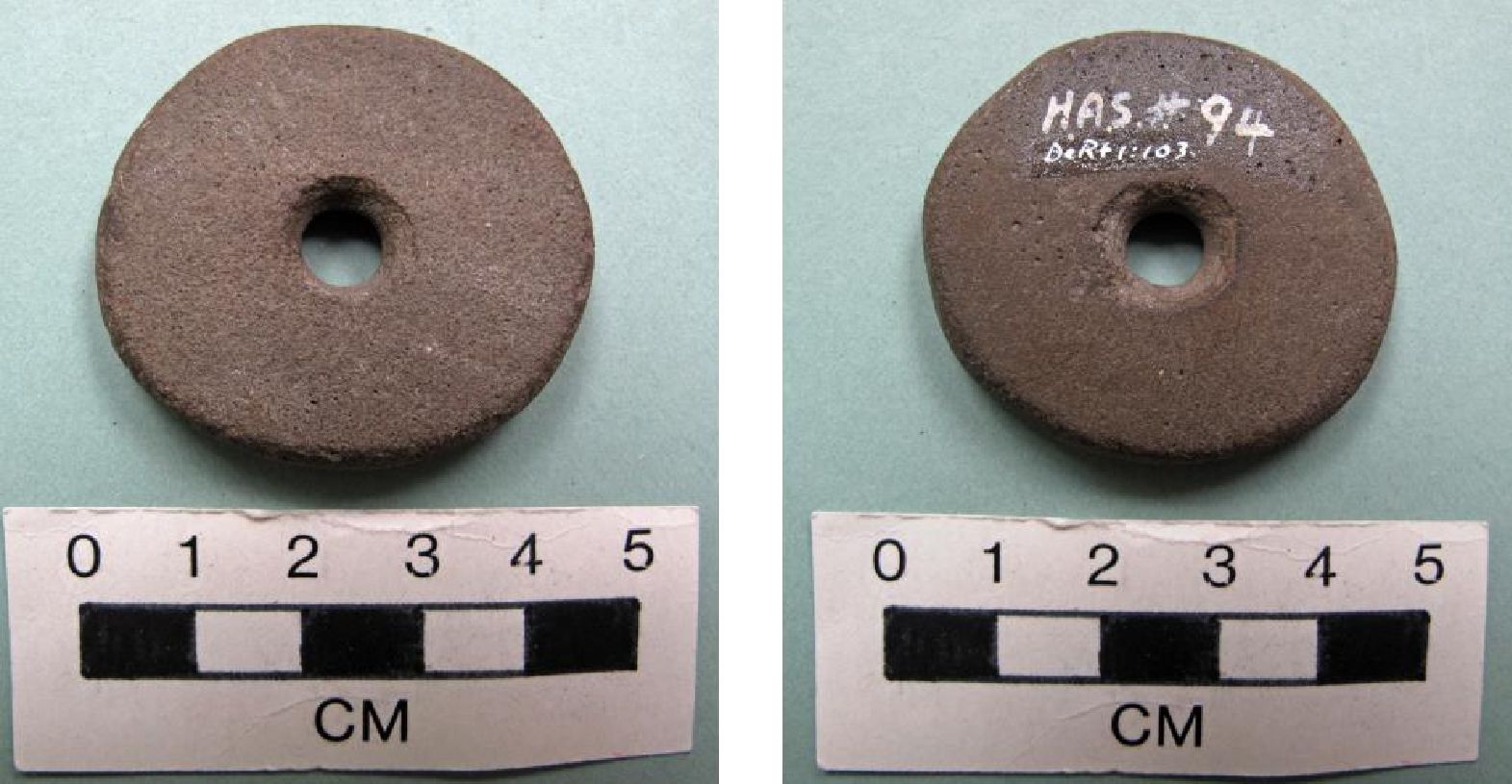
Lower Fraser River. (Total 3)
DjRi-Y:134. Yale area. Small disc shaped siltstone whorl. Bi-convex in cross-section. Weight: 31 grams. Diameter: 5.4cm. Thickness: 9.4mm at center and tapering to edges. Hole diameter: 9mm. [old #3134; Accession 1917.27].

DjR1-3:14. North of Yale. Unfinished round whorl. Flat on bottom and nearly flat on top surface. Schist-like material. Unfinished 4mm deep hole drilled at center on one side. Diameter: 45mm by 43mm. Thickness: 4.8mm at center tapering to an average of 4.5mm at outer edges. Weight: 15.9 grams. [Old accession # 12625; 65-48].
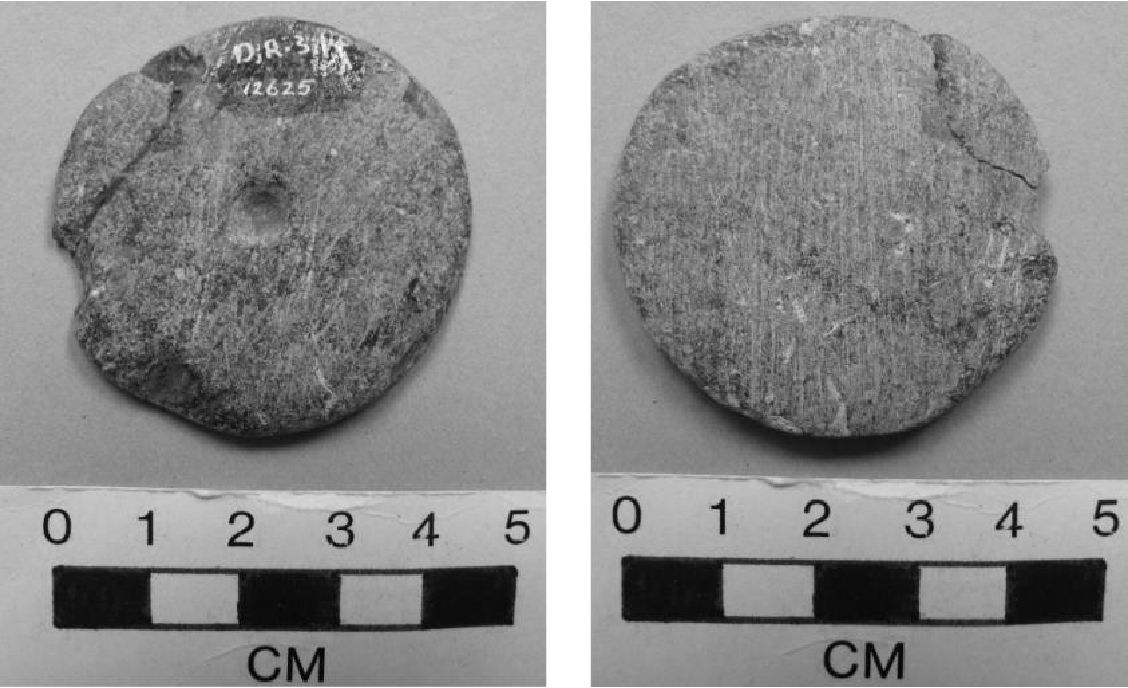
DhRlm-Y:1832. Agassiz-Dewdney general area. (67-4). Flat nearly round siltstone whorl with rounded edges. Bi-conically drilled hole. Diameter: 69-73mm. Thickness 8mm. Hole diameter: Inner 8mm, outer cut 13-14mm. Weight: 64.6 grams.
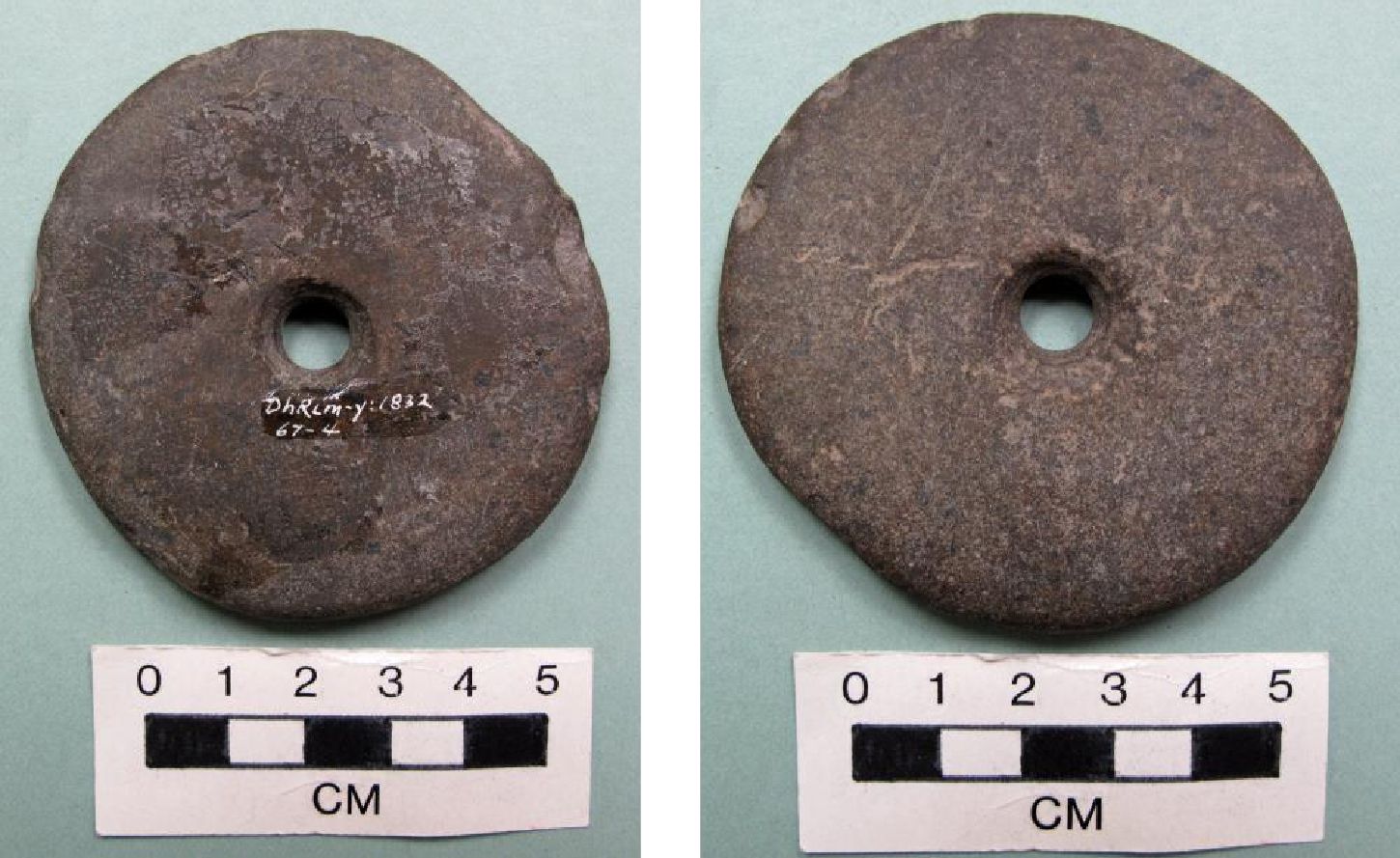
North end Vancouver Island/Mainland region (Total 2)
EdSo-Y:1. Lagoon Cove, Cracroft Island. Flat sea mammal vertebral epiphysis bone. Flat ground edges. Diameter: 72.5mm Thickness: 5.5cm. Hole diameter: 11mm; [old #5556; 425]. Surface collected by M. Miles. Became part of collection of A. and F.W. Barrow – #425. Weight: 22 grams.

EaSe-Y:23. Prideaux Haven. Siltstone whorl. Near flat to slightly bi-convex in cross-section. Ground around edges and high area on surfaces. Rough, unground portions on both sides. Diameter: 49mm to 49.9mm. Thickness: 4.7mm near centre and tapering to 3mm at edges. (old accession “5625”; Found by Phil Lavigne in 1938 and given to Francis Barrow. Part (#494) of A. and F.W. Barrow collection donation in 1944). Weight:16.1 grams.
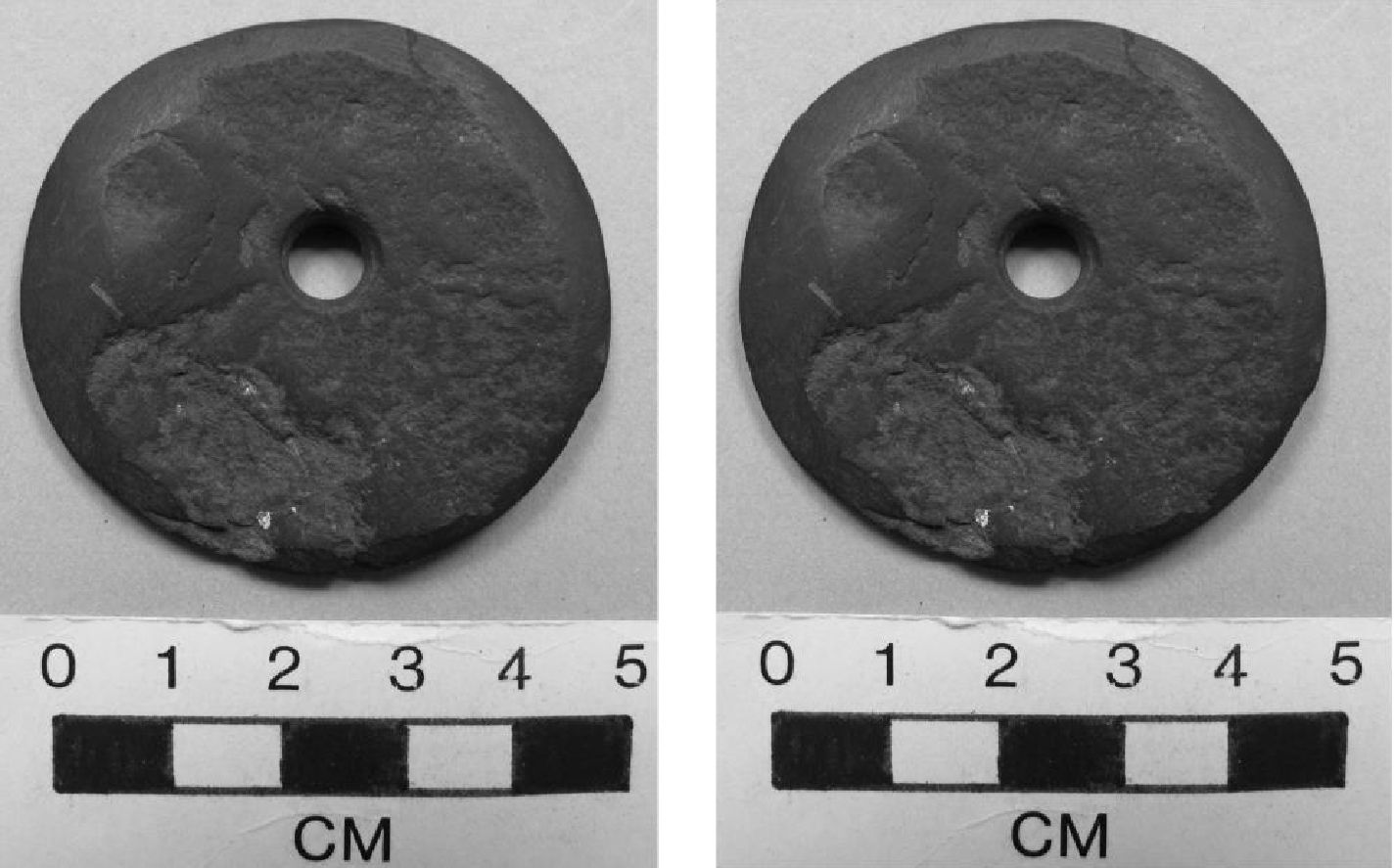
EdSv-6:20 Quatsino Sound. Sea mammal bone whorl. Bi-convex in cross-section.
Diameter: 61.5–64.1mm. Hole diameter: 10.5mm. Thickness varies from 4mm at edge to 10.8mm at hole. Transferred from Ethnology. John Stephenson Collection. A-1985- 10. Weight: 37 grams.

Interior (Total 2)
EbRj-Y:39 Lytton area. Flat circular siltstone. Flattened to rounded edge. Bi-conically drilled hole. Diameter: 100–102mm. Thickness: 8cm. Hole diameter: 9mm [13mm hole depression area].[old catalogue #455, lists this as from “S.Thompson” [South Thompson River] 1892.3, from the collection of F.M. Stevenson of Lytton]. Weight: 147 grams.
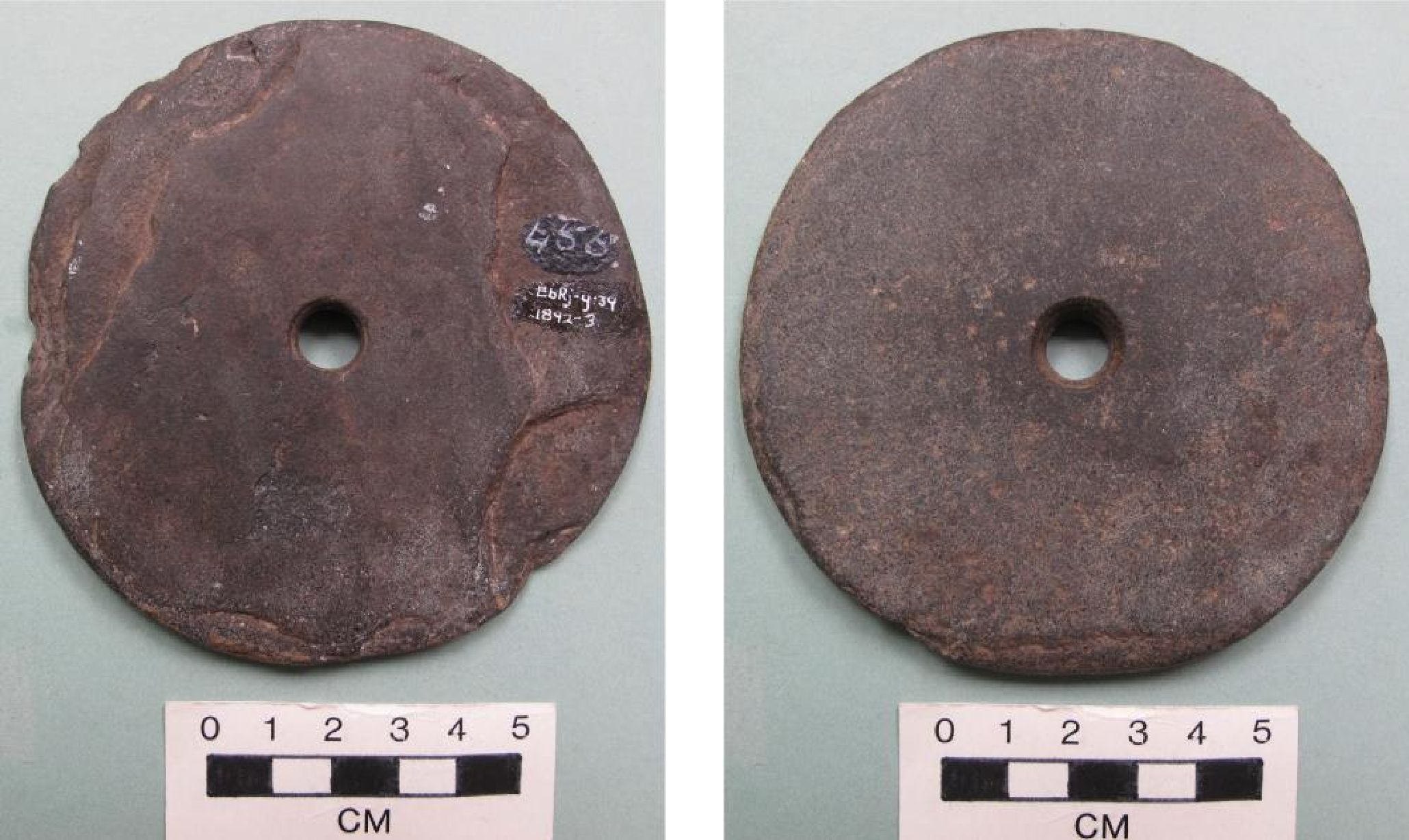
ER-Y:836. Southern Interior. Flat schist whorl fragment. Radius of piece from edge of hole to rim 41mm. Estimated diameter based on hole at center 90mm. Thickness: 9.3mm; Hole diameter estimate c. 9mm. Design pattern – A groove 3mm in from and around the edge separates a slightly lower area extending to the edge. Inside the grooved circle there is a star-like pattern formed by three 13mm high triangle patterns on the inside of the circular groove. Fire burn marks on one portion. “Interior Salish”. [old acc.66-6] Surface collected by H. Cowden. Weight: [47] grams (original estimated weight – c.120 grams).
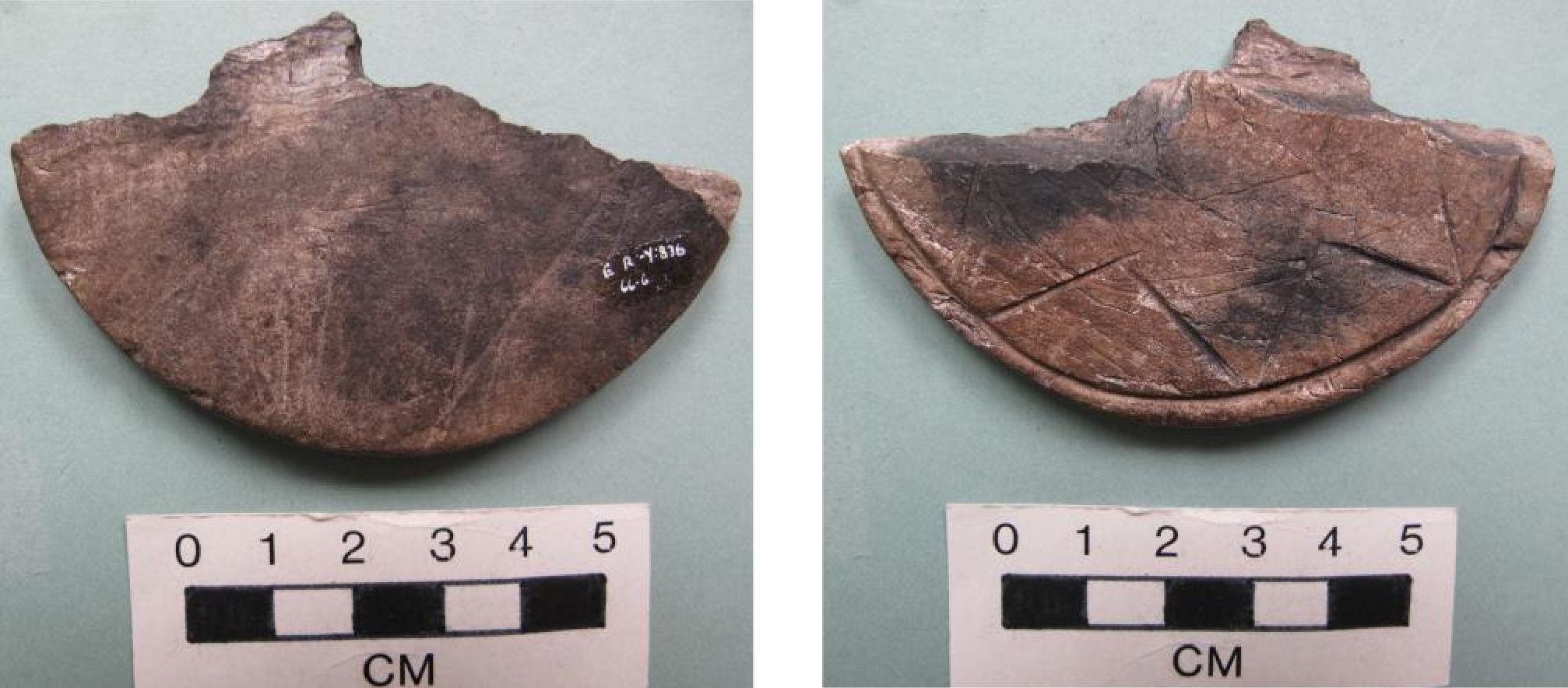
Central Coast (Total 3)
FcTe-4:458. Price Island. Sea mammal vertebrae epiphysis bone whorl fragment.
Diameter: 77mm. Oval shape; only half present; Thickness: 4mm; Diameter of hole: 6mm. [accession #72-362] Weight: 11.2 grams.
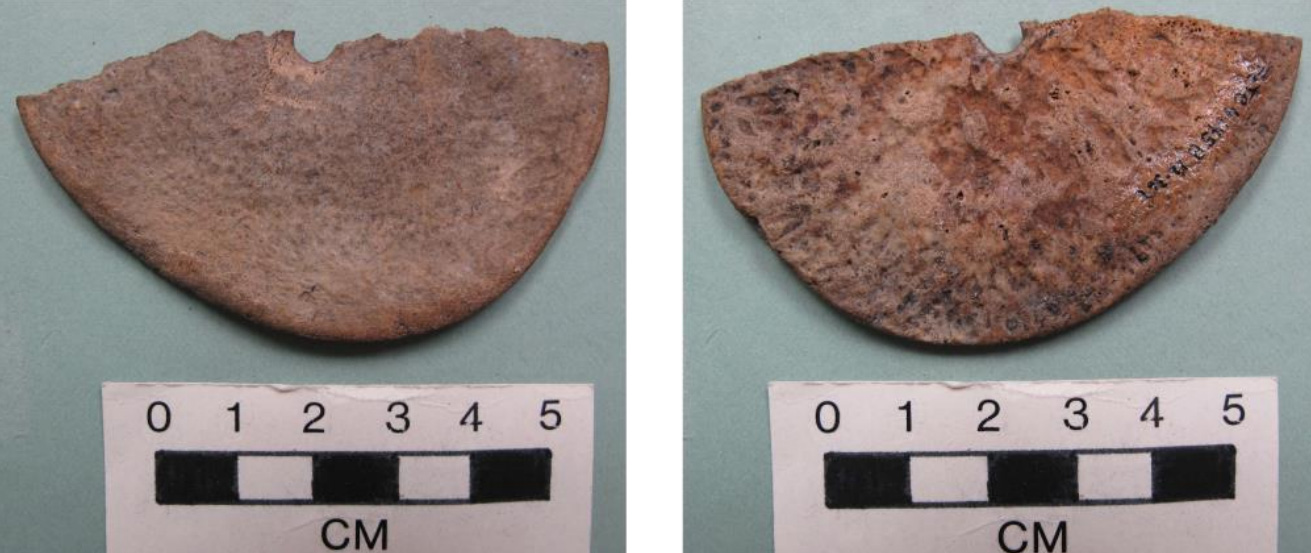
EkSp-13:5293. Owikeno. Sea Mammal bone whorl. Flat. Diameter: 61mm by 60mm. Thickness 6mm. 5.5mm on edges. Hole diameter: 11mm. Weight: 25.8. Excavations 24.7.75. N.E. Quadrant. Likely date 18th to early 19th century.
EkSp-13:5542. Owikeno. Sea Mammal bone whorl. Flat. Diameter: 52mm by 50.5mm. Thickness 8mm. 7.5mm on edges. Hole diameter: 11mm. Weight: 24.8. Excavations 24.7.75. S.W. Quadrant. Likely date 18th to early 19th century.
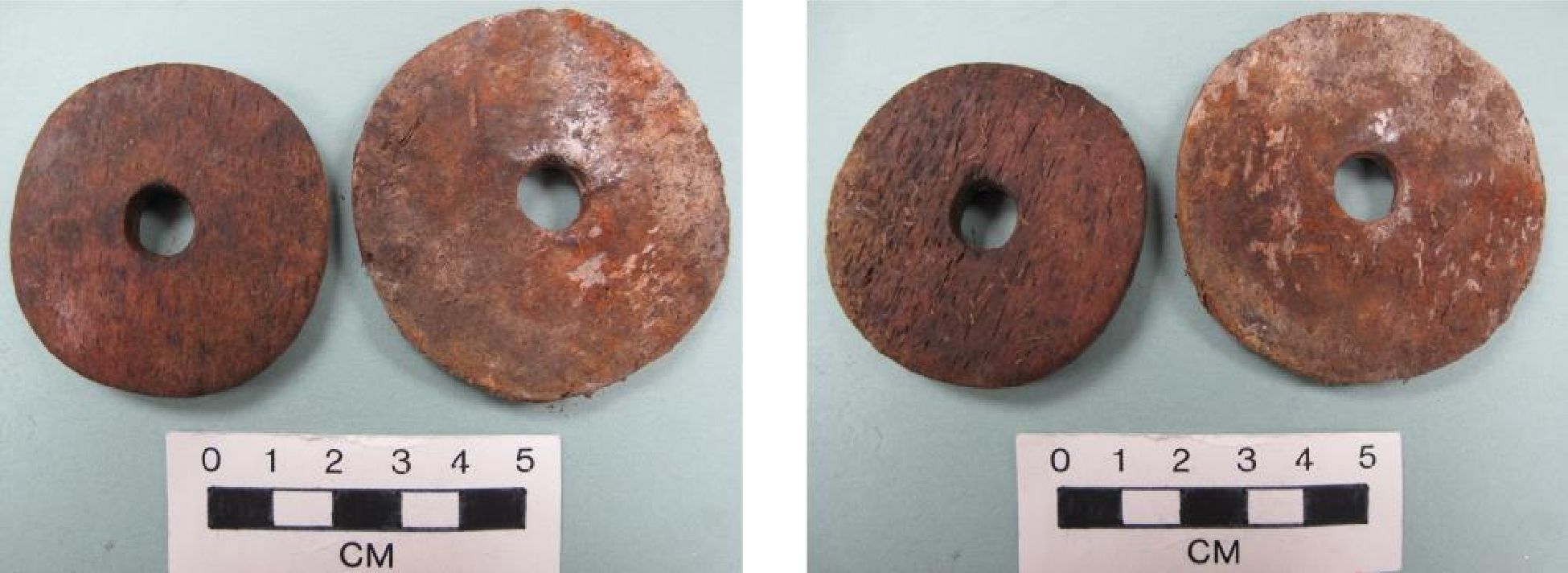
B.C. Unknown Location (Total 1)
Y:1879. Stone. Flat surfaces, but with 7mm wide angled faceting around edges on both sides. Edges ground flat. Weight: 67 grams. 6.4-6.5cm dia.; .5-.6cm flat edge; 1cm max. th.; hole .9cm (1.9cm hole depression area).

Possible whorl? DhSb-11:31. There is no evidence of a central hole, but other dimensions suggest that this is a whorl.
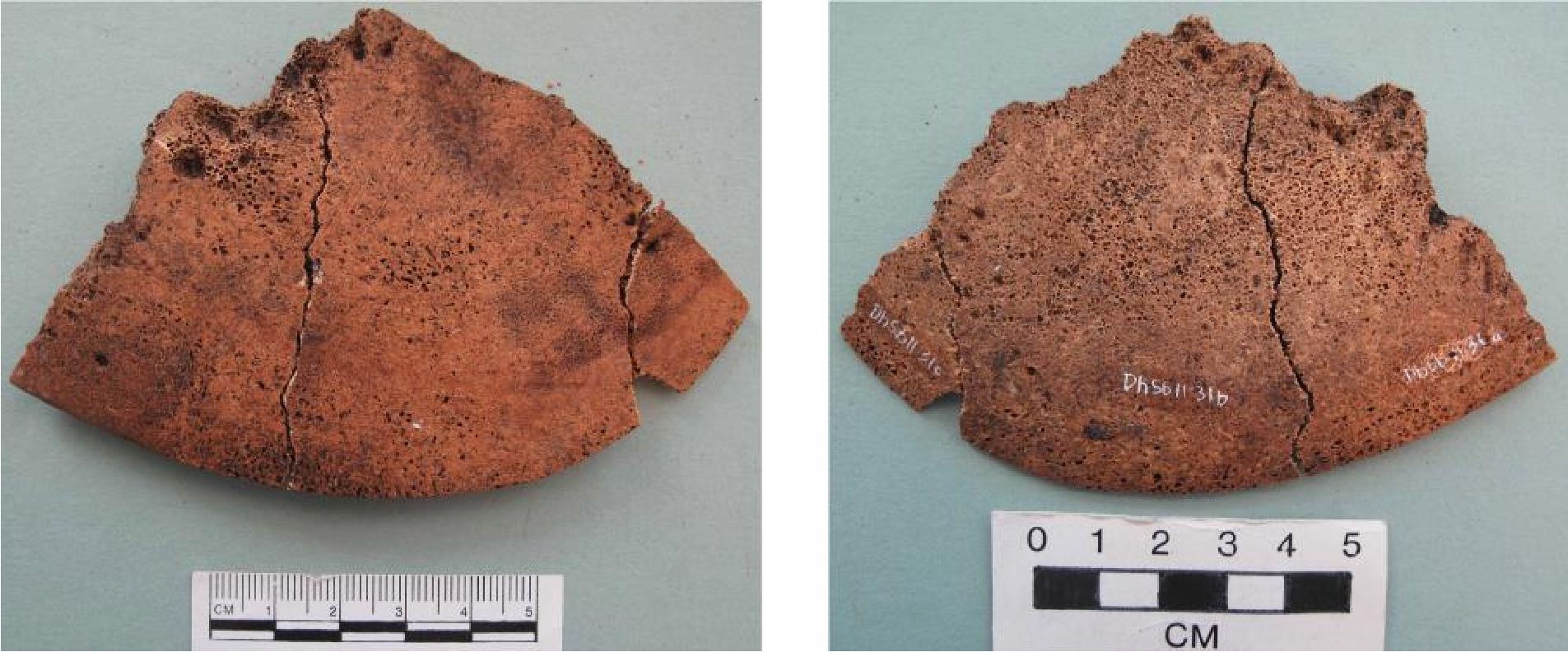
DdRu-5:85a&b. Unidentified object. This item was originally described as a possible whorl but I matched another piece, DdRu-5:159, which showed that the placing of the ground edges meant this could not be a whorl.

Dating and context of spindles from other collections
Haida Gwai. A spindle whorl was found on the floor of a habitation rock shelter, FaTt- 36:2. The site is located on the south shore of Djitkan Ankun near Cape Freeman, S.W. Coast of Moresby Island (Acheson 1998:188&202). (Dia. 78.2mm; Th. 6.9mm; hole dia. 12mm. Weight not given). Date unknown.
Queen Charlotte Strait. Two sea mammal bone spindle whorls were found at Davies Island Fort site, EeSp-95a, off Fife Sound (Mitchell, 1981:118; Fig. 37p&q) (Dia. abt. 37mm & abt. 63mm (Mitchell, 1981:118 and Mitchell 1988:251, fig.4).
These are only associated with the deposits of a general time period containing what is called the Queen Charlotte Strait Culture Type assemblage which dates from after AD 300 to near the historic period. (Mitchell 1988:251; figure 4i). (Dia. 32mm; Dia. of hole 5.5mm).
A “bone spindle whorl” was found in a shell midden at the head of Echo Bay, site EeSo-1, on the northwest shore of Gilford Island. Known as an historic period Kwicksutaineuk village (Mitchell, 1981:109; fig. 33m).
South-eastern Vancouver Island
DcRw-14:303. 135mm by 125mm; thick 18mm. Private collection of Gordon Crowe. Lower Fraser River
Lower Fraser River
Charles Borden describes a fragment of a spindle whorl from the old Musqueam village of Stselax, site DhRt-2, as a: “Marginal fragment of an elaborately and bifacially engraved spindle whorl fashioned from the epiphysis of a whale vertebra”. This site dates from 1250 AD to late contact times, but Borden suggests that the spindle whorl fragment was among artifacts that were “probably carved and engraved with steel cutting tools during the Historic Period” (Borden 1983:165;Figure 8:34c).
Fraser River Canyon
Charles Borden excavated a small “brown steatite” spindle whorl (DjRi-3L11.142) from the Milliken site in the Fraser River canyon (Diameter: 11.45cm). It has Snake motifs
engraving on one side and multiple snake eyes on the other. Borden placed it in the Esilao Phase dating to after 1380 A.D., but then suggested that it is “more likely” to date to the “Historic Period”. He stated that: “On the available evidence it is perhaps best to consider this steatite whorl more of less contemporary with the carefully designed compositions on some of the elaborately carved spindle whorls of the nineteenth century, bearing in mind, however, that future data and deeper insight may eventually justify placing this remarkable artifact into an earlier period” (Borden 1983:161).
Interior
Sanger reports two stone spindle whorls from the Texas Creek site. “Steatite spindle whorls are known from the Mile 28 Ranch Site, but to date they have not been found around Kamloops. The proximity of these site (the Texas Creek and the Mile 28 Ranch) to the Coast, where the spinning of mountain goat hair was practiced, may offer a partial explanation for the presence of these artifacts in the western periphery of the Interior plateau” (Sanger 1968:13).
References
Acheson, Steven. 1998. In the Wake of the ya’aats’xaatgaay [‘Iron People’]: A study of changing settlement strategies among the Kungit Haida. BAR International Series 711.
Barber, Elizabeth J.W. 1991. Prehistoric Textiles. The Development of Cloth in the Neolithic and Bronze Ages with Special References to the Aegean. Princeton University Press.
Borden, Charles. 1983. Prehistoric Art of the Lower Fraser River Region. Pages 131-165. In: Indian Art Traditions of the Northwest Coast. Edited by Roy Carlson.
Keddie, Grant. 2003. A New Look at Northwest Coast Stone Bowls. In: Archaeology of Coastal British Columbia. Essays in Honour of Professor Phillip M. Hobler, pp. 165-174. Edited by Roy L. Carlson. Publication Number 30, Archaeology Press, Simon Fraser University.
Mitchell, Donald. 1988. Changing Patterns of Resource Use in the Prehistory of Queen Charlotte Strait, British Columbia, Pages 245-290. In: Research in Economic Anthropology. Edited by Barry L. Isaac, Supplement 3. Prehistoric Economies of The Pacific Northwest Coast.
Loughran-Delahunt, Isa. 1996. A Functional Analysis of Northwest Coast Spindle Whorls. Master of Arts. Western Washington University.
Mitchell, Donald. 1981. Test Excavations at Randomly Selected Sites in Eastern Queen Charlotte Strait. Pp. 103-123. In: B.C. Studies. Fragments of the Past: British Columbia Archaeology in the 1970s. No. 48, Winter, 1980-81.
Sanger, David. 1968. The Texas Creek Burial Site Assemblage, British Columbia. Anthropological Papers National Museum of Canada, Number 17, Ottawa.
